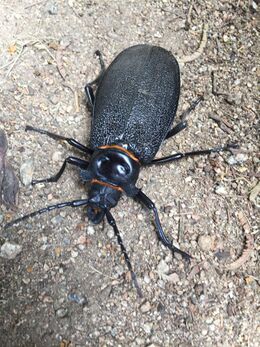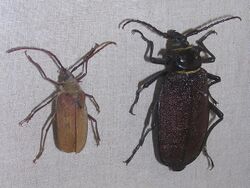Biology:Acanthinodera cumingii
| Acanthinodera cumingii | |
|---|---|

| |
Not evaluated (IUCN 3.1)
| |
| Scientific classification | |
| Kingdom: | |
| Phylum: | |
| Class: | |
| Order: | |
| Suborder: | |
| Family: | |
| Genus: | Acanthinodera
|
| Species: | A. cumingii
|
| Binomial name | |
| Acanthinodera cumingii Hope, 1833
| |
Acanthinodera cumingii (Spanish: Madre de la Culebra, literally "mother of the snake") is a longhorned beetle in the family Cerambycidae and subfamily Prioninae.[1] It is the only species in the genus Acanthinodera,[2] and is one of the largest species of beetle in Chile.[3] The beetle is endemic to central Chile and can be found from IV Coquimbo Region to IX La Araucanía Region.
Range
The species is endemic to Chile , and can be found from the south of the Region of Coquimbo to the Malleco Province in the Region of Araucanía. It can be found from sea level to the Precordillera hills.[4]
Conservation
In its native habitat in Chile the insect is vulnerable to habitat destruction from logging and construction.[5] Due to its large size, the beetle is also vulnerable to being caught and killed by people, exacerbating the danger of extinction.[citation needed]
Description
The species has a particularly marked sexual dimorphism,[5] which originally led naturalists to classify the male and female as distinct species. The male measures 5 to 6 cm, is light brown and clearly differs from the female. The female is black and measures between 8 and 9 cm on averages, although specimens exceeding 12 cm in length have also been found. The male is nocturnal and can fly, while the female is diurnal and does not fly.[6]
Life cycle
The life cycle of A. cumingii has been little studied. The females lay more than 100 white eggs resembling grains of rice in the dry trunks of trees and in decomposing vegetation.[3] The length of time between eggs and adulthood can take six years, depending on humidity and food availability.[4] Larva can reach sizes as large as 13 cm in length.[5][7] For this reason the common name of the insect is "the mother of the snake" in Spanish.
The insect plays an important ecosystem role in decomposition of dead wood. The larval stage has been found living in approximately 30 species of trees, both indigenous and invasive. This includes Eucalyptus which is an invasive tree in Chile.[4]
The insects are occasionally preyed upon by mammalian carnivores, such as foxes. However, the strong jaws of the insect, used for eating wood, may provide a defense.[6]
Synonyms
- Acanthinodera cumigii Jeniš,
- Acanthinodera cumingi Bleuzen,
- Acanthinodera cumingii Elgueta & Cerda,
- Acanthinodera cummingi Barriga & al., 1993
- Acanthinodera cummingii Arias, 2000
- Amallopodes scabrosus Blanchard, 1851
- Ancistrotus cumingi Angulo & Weigart, 1974
- Ancistrotus cummingi Cekalovic, 1967
- Malloderes microcephalus Berge, 1844
- Malloderus microcephalus Drapiez, 1841
- Prionus cumingii Hope, 1833
- Prionus mercurius Berge, 1844[1]
References
- ↑ 1.0 1.1 "Catalog of Life: Acanthinodera cummingi Gazulla & Ruíz, 1929". April 2015. http://www.catalogueoflife.org/col/details/species/id/c75c4817e55e8693d7b67bbe4a07a97d/synonym/d7ea8e0733dd09c712e65ce6d810fe96.
- ↑ Bezark, Larry G. A Photographic Catalog of the Cerambycidae of the World . Retrieved on 22 May 2012.
- ↑ 3.0 3.1 "FICHA DE ANTECEDENTES DE ESPECIE: Acanthinodera cummingi". 2016. http://www.mma.gob.cl/clasificacionespecies/fichas13proceso/fichas-inicio/Acanthinodera_cumingii_INICIO_13RCE.pdf.
- ↑ 4.0 4.1 4.2 Fuentes Olivares, Pablo; Araneda Olivares, Cristóbal (2016). "Primer registro de larva de Acanthinodera cumingii (Hope, 1833) (Coleoptera: Cerambycidae) en el arbusto invasor Ulex europaeus L.". Biodiversity and Natural History 2: 1–5.
- ↑ 5.0 5.1 5.2 "Madre de la Culebra". http://www.surmagico.cl/la_madre_de_la_culebra.htm.
- ↑ 6.0 6.1 Zúñiga-Reinoso, Álvaro (2016). "Acanthinodera cumingii (Coleoptera: Cerambycidae) in the diet of carnivores of the Nahuelbuta Mountain Area, south-central Chile". Journal of Entomology and Zoology Studies 4: 696–698.
- ↑ Angulo, A (1974). "Endogamia, endemismo y teratología en insectos". Boletín de la Sociedad de Biología de Concepción 47: 297–301.
External links
Wikidata ☰ Q1706648 entry


